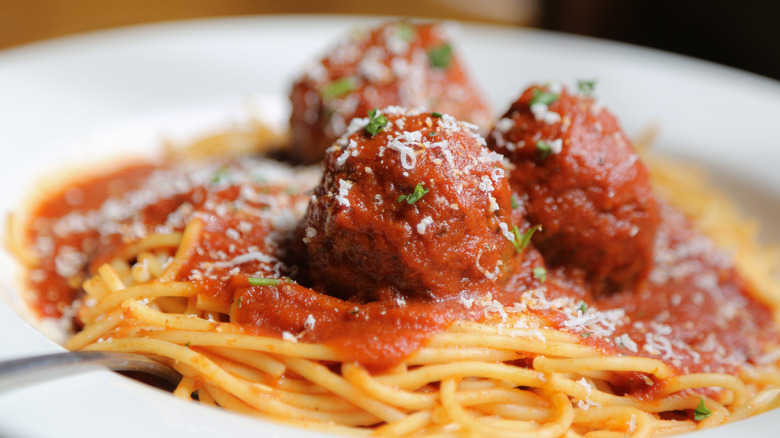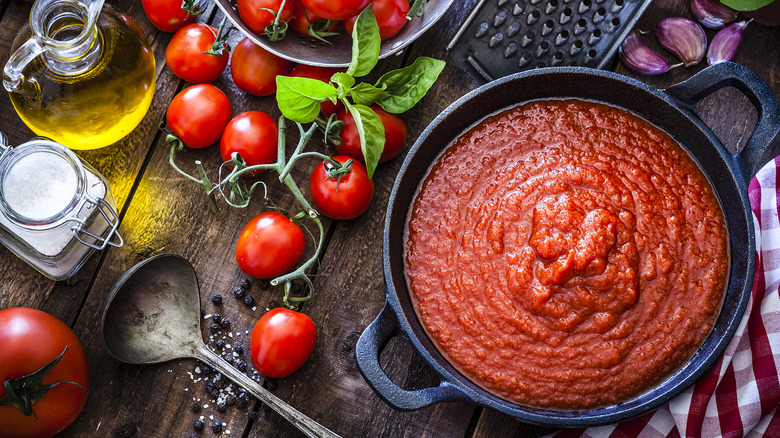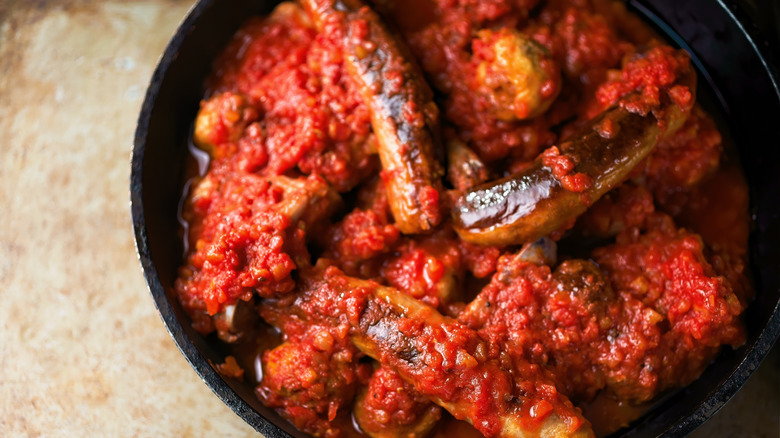Why Pasta Sauce Is Sometimes Called Gravy
If you've resided in the tri-state area over the last century, you've likely been caught in the crossfire of a passionate debate over the difference between pasta sauce and gravy. As a tribe member, I have a strong opinion on the topic, passed down by generations of Italian Americans who "know" they are right. Despite theories about why pasta sauce is sometimes called gravy, they are riddled with inconsistencies, leaving both sides defensive, since the food is intrinsically linked to Italian culture.
This debate exists only in the United States. In Italy, neither term is used. Pasta sauce made with tomatoes, olive oil, onions, and garlic is called sugo, which serves as the base for other tomato-based sauces like all'arrabiata and all'Amatriciana. When sugo is slow-cooked with meat, Italians refer to it as ragù. Each region has a version using beef, pork, or other proteins, but perhaps the most well-known meat-based sauce comes from Italy's Emilia-Romagna region in the north: fettuccine alla Bolognese.
Some food historians like Simone Cinotto and Lorraine Ranalli, author of "Gravy Wars," believe geography plays a role in what you call pasta sauce, discovering that gravy is primarily used on the East Coast in sections of Philadelphia, New York, and Boston. However, that doesn't account for Italian immigrants in Chicago and New Orleans who are also familiar with gravy, unlike pockets of NYC's five boroughs. Others point to etymology or the timing of an individual's immigration, but like many things, there's always a contradiction.
The argument for calling it sauce
In the U.S., "pomodoro" (Italian for tomato) describes a chunky tomato sauce used to top pizza and pasta. In Italy, it's less straightforward as there are both salsa di pomodoro and sugo di pomodoro, which are vastly different. Salsa is quickly cooked and prepared with minimal ingredients, while sugo begins by sauteing a battuto (onions, garlic, celery, basil, and parsley) and is simmered until the sauce has thickened.
Unlike salsa, sugo is traditionally pureed before serving. Despite their nuances, both dishes are translated to "pomodoro sauce" in English. This adaptation led Jersey girl Nancy Carnevale, author of "A New Language, A New World: Italian Immigrants in the United States, 1890-1945," to point to the etymology of the word "salsa" to explain why some Italian Americans use the word "sauce." Just say the words aloud quickly — they sound very similar.
There are two ways Italian Americans use the term "sauce." Some use it to describe a red sauce that doesn't contain meat. These people, like me (a first-generation Italian American), would use the word interchangeably with marinara. In contrast, others use it to describe anything that goes on pasta, regardless of whether it contains meat. Pisanos, who always call it sauce, are in good company, as film director Martin Scorcese, the unofficial authority on Italian American culture, made it clear in the introduction to his mother's cookbook, "Italianamerican: The Scorsese Family Cookbook," that he's team sauce.
The argument for calling it gravy
It's a bit harder to parse how ragù became gravy, but there are a few theories as to why some Italian Americans differentiate between sauce and gravy. Roberto Dolci, a linguist at Università per Stranieri di Perugia, believes that some immigrants adopted the English term to assimilate into American culture. Rather than using only "sauce," which casually sounded too much like salsa, they changed the meaning of gravy to fit in.
Other individuals think that primarily early Italian immigrants used the term gravy, while newer ones settled on calling it sauce. Over 4 million Italians immigrated between 1880 and 1924, with a majority coming from Southern Italy, including Sicily. After the 1920s, the numbers tapered off, which can also support why some people think Southern Italians use the term gravy and Northerners don't. The two theories work together.
As a Southern Italian whose grandfather came over in the 1920s, this certainly can explain why we have Sunday gravy filled with hot Italian sausage, meatballs, and pork ribs, not sauce. Obviously, when people argue that gravy is brown and belongs on turkey or roast beef, there's no disputing that none of this conversation really matters if you are enjoying the meal with friends and family. Apparently, team gravy is a dying breed, although I hope that my kids will carry on the family tradition of enjoying macaroni with gravy every Sunday afternoon.



